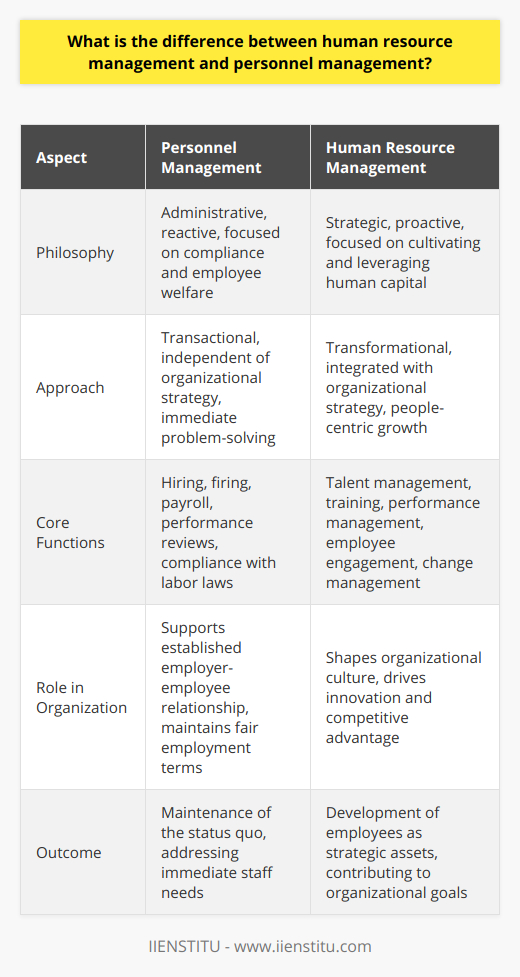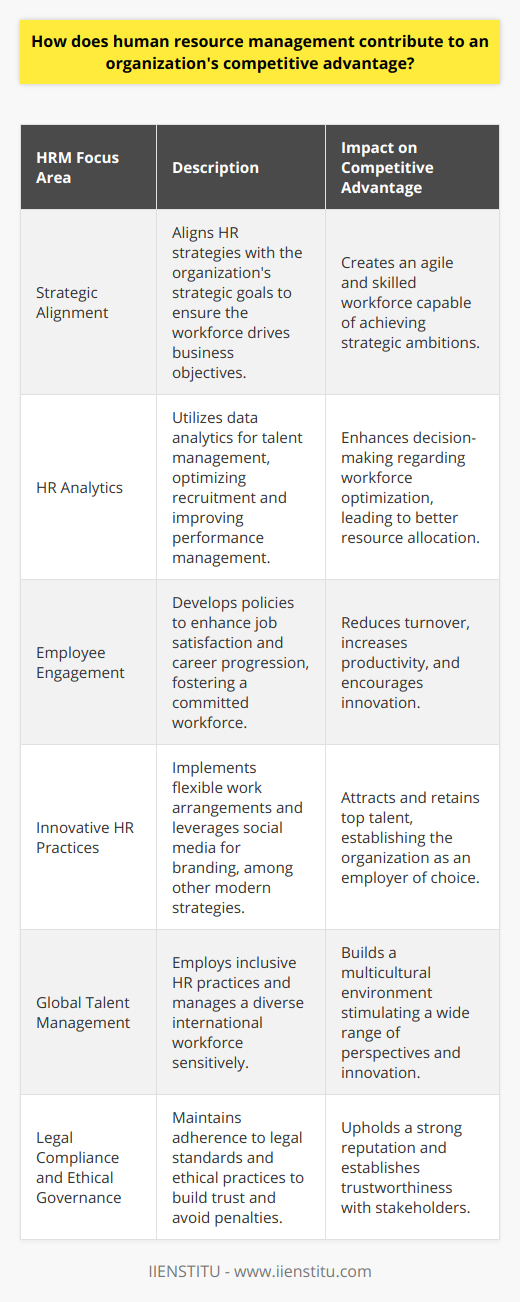I remember when I first began my career, fresh out of university, I had little understanding of the critical role that human resources played within an organization. To me, HR was just the department that handled paperwork, orientation, and maybe the occasional team-building exercise. But as I progressed through different roles and encountered various challenges, I began to appreciate just how integral human resource management (HRM) is to the success of any company.
Human resource management isn't just about hiring and firing; it's about managing people in organizations in a way that aligns with strategic objectives. In its most basic form, HRM is concerned with employee recruitment, retention, and development. But let's be honest, it's so much more than that. The primary role of HRM is to help organizations achieve their strategic goals by attracting, developing, and retaining the best talent.
Over the years, the role of human resource management has evolved significantly. Organizations have realized that their most important asset is their people. Back in the day, HR was often seen as a support function—necessary but not central to the business's success. Today, however, HR sits at the strategic table. The focus has shifted to strategic human resource management, where HRM is aligned with the organization's overall strategy to attract, develop, and retain the best talent.
The Evolving Role of Human Resource Management
I recall a conversation with a former colleague who worked in the HR department of a large multinational. She mentioned how HR used to be viewed merely as administrative support—the folks who handled payroll and organized the annual company picnic. But times have changed. Nowadays, HR professionals are expected to be strategic partners, driving business strategy and contributing to organizational success.
The job of HR now involves leveraging human capital to gain competitive advantage. That's where strategic HR management comes into play. This approach ensures that HR policies and practices are integrated with the organization's strategic objectives. It's about thinking ahead and planning ways for a company to better meet the needs of its employees, and for employees to better meet the needs of the company.
By focusing on human and resource management strategically, companies can ensure they have the right people in the right roles at the right time. It's a complex puzzle, but when managed effectively, it leads to incredible results.
Main Functions of Human Resource Management
HRM has three main functions: talent acquisition, talent development, and talent management. Let me walk you through these, perhaps with some stories from my own journey.
Talent Acquisition: Finding the Right Fit
When I was working at a mid-sized tech startup, one of our biggest challenges was finding the right talent. We needed people who were not only technically skilled but also a good cultural fit. I remember sitting in on interviews where candidates had impressive resumes but didn't quite resonate with our team dynamics.
Talent acquisition isn't just about filling open positions; it's about attracting and recruiting the best candidates who align with the company's culture and values. HR professionals must have a deep understanding of both the technical requirements of a role and the soft skills that will make someone successful in the organization.
Ergonomic Practices For Productivity And Comfort İn Modern Workspaces
Human Resource Management Skills For Non-hr Managers Examples
Unsupported block: unknown
At that startup, our HR team started implementing some innovative strategies:
Leveraging social media platforms to reach a wider audience.
Partnering with universities and coding boot camps to tap into fresh talent pools.
Offering competitive salaries and human resources resources benefits to attract top candidates.
They knew that to compete with larger companies, we had to offer something unique—like opportunities for rapid growth and a dynamic work environment.
One of the HR managers explained to me that they were employing the critical path method project management strategy to streamline the hiring process. By identifying the critical steps in recruiting and onboarding, they reduced the time to hire significantly. This strategic approach not only filled positions faster but also improved the quality of candidates we attracted.
Talent Development: Investing in Growth
Once we had the right people on board, the next challenge was talent development. Early in my career, I worked for a company that didn't invest much in employee development. The result? High turnover and low morale. People felt like they were stagnating.
In contrast, at another organization I joined later, there was a strong emphasis on continuous learning. The HR department organized regular workshops, brought in guest speakers, and even offered tuition reimbursement for further education. I took advantage of a leadership training program that not only enhanced my skills but also made me feel valued.
Human resource HR professionals play a pivotal role here. They design and implement development programs that help employees grow. This benefits not just the individuals but the company as a whole. After all, when employees improve, they bring new ideas and efficiencies to their work.
One strategy that worked well was personalized learning pathways. By assessing each employee's strengths and areas for improvement, HR could tailor development plans that were both engaging and effective. This level of attention made a significant difference in employee satisfaction.
Some effective talent development initiatives include:
1- Mentorship Programs: Pairing less experienced employees with seasoned professionals.
2- Continuous Learning Opportunities: Providing access to courses and certifications.
3- Leadership Training: Preparing employees for future managerial roles.
4- Feedback Systems: Implementing regular performance reviews for growth.
Talent Management: Retaining and Engaging
Of course, hiring and developing talent is only part of the equation. Talent management is about retaining that talent and ensuring employees are engaged and motivated.

I once managed a team where one of our key members was considering leaving the company. She felt her career had plateaued, and she wasn't sure if there was room for advancement. I collaborated with our HR partner to develop a career plan that included new responsibilities and opportunities for growth.
This experience taught me the importance of HR's role in resource allocation and career development. By actively managing talent, HR helps employees envision a future within the company, which can significantly reduce turnover.
At another company, HR introduced an employee recognition program. Regular acknowledgment of achievements, both big and small, fostered a positive work environment. It's amazing how a simple "thank you" or public recognition can boost morale.
Key components of effective talent management include:
Career Development Plans: Mapping out career paths for employees.
Employee Engagement Initiatives: Creating a positive work culture.
Succession Planning: Preparing for future leadership needs.
Performance Management Systems: Setting clear goals and expectations.
The Impact of HRM on Organizational Success
Human resource management has a profound impact on the success of an organization. Effective HR management aligns the workforce with the company's strategic objectives, ensuring everyone is moving in the same direction.
From my experience, companies that invest in HR management often outperform those that don't. This isn't just about having policies in place but about creating a culture where employees feel valued and engaged.
The Roles Within HR
HR departments typically encompass various roles, each critical to the overall function. Here's a quick rundown:
1- Recruitment Specialists: Focus on finding and attracting talent.
2- Training and Development Managers: Oversee employee learning initiatives.
3- Compensation and Benefits Analysts: Manage employee remuneration and benefits packages.
4- Employee Relations Managers: Handle workplace disputes and promote a positive working environment.
5- HR Business Partners: Work closely with business units to align HR strategies with business goals.
These roles demonstrate the diverse nature of HR and its importance in every aspect of the organization.
Challenges Faced by HR Professionals
HR professionals face numerous challenges, such as:
Adapting to technological changes.
Managing a diverse workforce.
Ensuring compliance with labor laws.
Strategic planning and implementation.
Balancing organizational needs with employee well-being.
Addressing these challenges requires a strategic approach and a commitment to continuous improvement.
The Key Takeaways
In summary, the role of human resource management is more critical than ever. By focusing on:
Talent Acquisition: Attracting the right people.
Talent Development: Investing in employee growth.
Talent Management: Retaining and engaging talent.
Companies can achieve greater success.
I can't emphasize enough how pivotal HR is in shaping the culture and success of an organization. As someone who has seen both sides—the benefits of effective HRM and the drawbacks when it's lacking—I can attest to its importance.
Personal Reflections
Looking back, I realize that the times I felt most fulfilled in my career were when I was part of organizations that valued their human resources and invested in them. When resource HR is taken seriously, employees notice the difference. They are more engaged, more productive, and more committed.
I encourage anyone interested in organizational success to consider the role of HR carefully. Whether you're an aspiring HR professional or a manager looking to improve your team's performance, understanding HRM is invaluable.
Final Thoughts
In the dynamic business environment of today, companies must be agile and forward-thinking. This requires not just a sound business strategy but also an effective HR human approach. After all, businesses are run by people, and human resources are the driving force behind any organization's success.
By integrating strategic business goals and human resources practices, organizations can create a synergy that propels them forward. The job of HR is no longer just administrative; it's strategic, influential, and essential.
References
Armstrong, M. (2014). Armstrong's Handbook of Human Resource Management Practice. Kogan Page.
Dessler, G. (2017). Human Resource Management. Pearson.
Ulrich, D., & Brockbank, W. (2005). The HR Value Proposition. Harvard Business Review Press.














